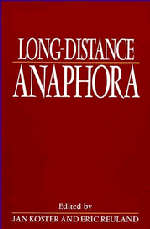Book contents
- Frontmatter
- Contents
- List of contributors
- Preface
- 1 Long-distance anaphora: an overview
- 2 Containment and connectedness anaphors
- 3 Long-distance reflexives and the typology of NPs
- 4 Contextual determination of the anaphor/pronominal distinction
- 5 On the interaction between antecedent-government and binding: the case of long-distance reflexivization
- 6 Binding in Polish
- 7 Anaphors in binary trees: an analysis of Czech reflexives
- 8 Latin long-distance anaphora
- 9 Prepositions, binding and θ-marking
- 10 Locality, parameters and some issues in Italian syntax
- 11 Long-distance binding in Finnish
- 12 The primacy condition of anaphora and pronominal variable binding
- 13 The local nature of the long-distance reflexive in Chinese
- 14 Anaphors and logophors: an argument structure perspective
- References
- Index
3 - Long-distance reflexives and the typology of NPs
Published online by Cambridge University Press: 01 June 2011
- Frontmatter
- Contents
- List of contributors
- Preface
- 1 Long-distance anaphora: an overview
- 2 Containment and connectedness anaphors
- 3 Long-distance reflexives and the typology of NPs
- 4 Contextual determination of the anaphor/pronominal distinction
- 5 On the interaction between antecedent-government and binding: the case of long-distance reflexivization
- 6 Binding in Polish
- 7 Anaphors in binary trees: an analysis of Czech reflexives
- 8 Latin long-distance anaphora
- 9 Prepositions, binding and θ-marking
- 10 Locality, parameters and some issues in Italian syntax
- 11 Long-distance binding in Finnish
- 12 The primacy condition of anaphora and pronominal variable binding
- 13 The local nature of the long-distance reflexive in Chinese
- 14 Anaphors and logophors: an argument structure perspective
- References
- Index
Summary
Introduction
Part of the importance of linguistic theories, as well as other scientific theories, is that they tell you which facts are interesting, why they are interesting, and where to look for other interesting facts. The standard binding theory (BT) of Chomsky (1981) has been extremely important in this respect since it has sparked a great deal of cross-linguistic research into the binding properties of pronouns, reflexives, and other NPs, overt and non-overt. As a result, we have learned a lot about the nature of NPs in various languages, what their similarities are and how they differ, both within a given language and cross-linguistically.
It is well known that one does not have to look very hard or very far to find, say, reflexives that do not obey the same restrictions as reflexives in English. The socalled long-distance reflexives found in various languages are a case in point (see, e.g., Thráinsson (1976a, c), Napoli (1979), Yang (1983), Hellberg (1984), von Bremen (1984), Giorgi (1984), Maling (1984), Anderson (1986), Rögnvaldsson (1986), Everaert (1986a), Barnes (1984, 1986), Sigurðsson (1986a), Sportiche (1986), Sells (1987), Manzini & Wexler (1987), Wexler & Manzini (1987), Pica (1987), Koster (1987), Kuno (1987), and references cited there). The question is, however, what the existence of such reflexives implies for BT. There are various possibilities, and different suggestions can be found in the literature cited above.
- Type
- Chapter
- Information
- Long Distance Anaphora , pp. 49 - 76Publisher: Cambridge University PressPrint publication year: 1991
- 21
- Cited by



